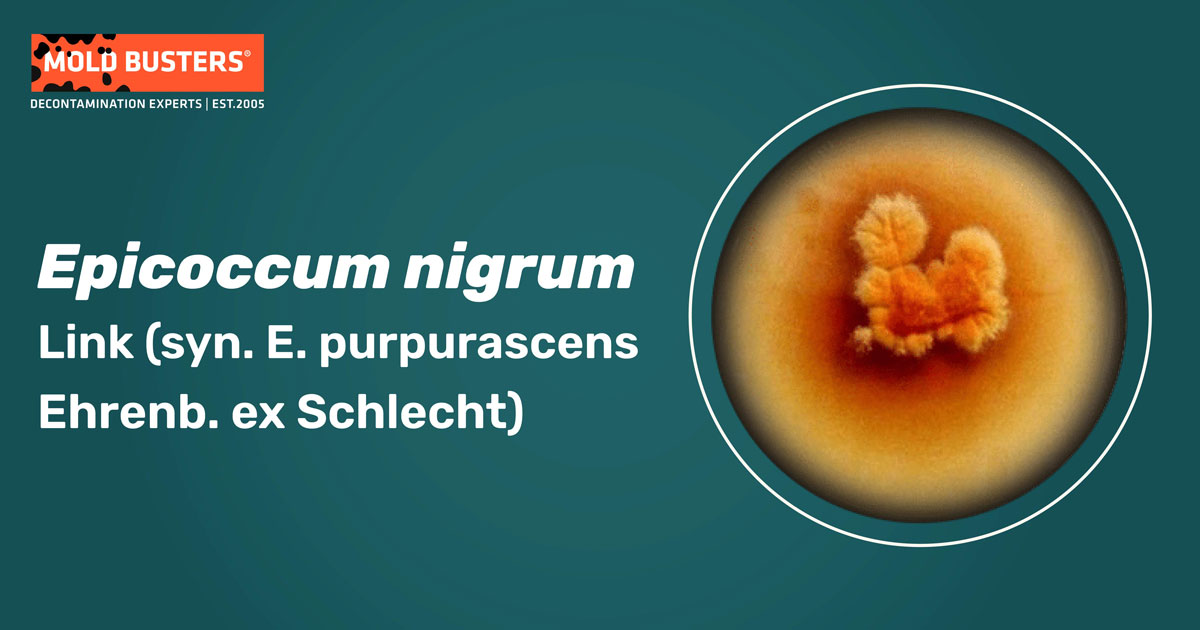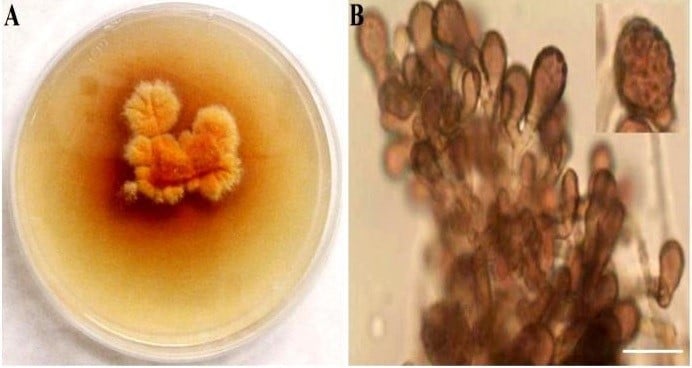Link (syn. E. purpurascens Ehrenb. ex Schlecht)
What is Epicoccum nigrum?
Epicoccum nigrum (synonym Epicoccum purpurascens) is a filamentous fungus belonging to the phylum Ascomycota and the Dothideomycetes class [1, 2]. It reproduces asexually since its sexual stage is unknown [1, 2]. It is also classified as a dematiaceous fungus, which means it has a characteristic brown color when grown in culture due to melanin production in cell walls [2, 3]. As a biological control agent against fungi that affect plant species and the production of different antimicrobial and bioactive compounds [1, 2, 3]. E. nigrum is also known as a pathogen of muskmelon [1], and it’s an adverse effect on human health [3].

Where can be Epicoccum nigrum found?
Epicoccum nigrum is a cosmopolitan mold found in a wide range of soils and outdoor and ambient air [1, 2, 3]. It has also been isolated from wood, paper, a wide range of textiles and food, insects, and human skin [3]. E. nigrum can also live inside plant tissues and on other fungal species (as a fungicolous species [1, 3].
Epicoccum nigrum genome
Epicoccum nigrum is considered a highly variable species. However, analysis of diversity in an E. nigrum population identified two different species within the E. nigrum complex. Species show different morphological, physiological, and genetic characteristics [1]. Research suggests that the E. nigrum complex contains species that appear identical but are genetically distinct (cryptic species). Therefore, the E. nigrum complex requires further studies to distinguish and clarify their relationships [1].
According to NCBI [4], the representative genome (the entire genetic information of an organism) of Epicoccum nigrum has an average length of 34.7 Mbp (Mbp = Mega base pairs = 1,000,000 bp = fundamental unit of DNA) and 12,025 protein-coding genes.
How does Epicoccum nigrum look like?
Morphologically, E. nigrum strains can be divided into two groups. Group 1 includes strains with abundant aerial mycelia and colonies with irregular margins and intense orange color on Potato Dextrose Agar (PDA) and maltose media (Fig 1A). Strains of group 2 exhibit dense mycelial growth on PDA and malt media, giving colonies with uniform edges and color range from purple, pink, red, gray, and brown. On the Czapek medium, both groups exhibit scarce mycelial growth and white to pale yellow colonies with uniform margins [1]. Two groups of the E. nigrum complex can also be distinguished based on growth rate. Strains of Group 2 exhibit a statistically higher growth index on all growing media [1].
Microscopically, hyphae are yellow to brown (Fig 1B). Conidiophores are short, colorless to light brown, originating directly on the hyphae. They are arranged mostly in clusters and are repeatedly branched, with conidiogenous cells at the tips. Each conidiophore produces one single-celled conidium, spherical to pear-shaped, about 15-25 mm in diameter. Mature conidia turn dark golden brown to black and become splitted by septae into up to 15 cells [3].

Epicoccum nigrum mold
Epicoccum nigrum mold is commonly found indoors in mold-infested buildings; it may be found on gypsum boards, flooring, carpet, and mattress dust, as well as on house plants. According to the reports, this species was also found in hospital air-conditioning and ventilation filtration systems [3].
Since Epicoccum species grow on leaves so often, indoor air quality in greenhouses and homes with house plants may be compromised [3].
Optimal conditions for E. nigrum growth are temperatures between 23-28 °C (73.4-82.4 °F) at pH 3-4.5, but it is capable of growing at temperatures between -3 °C and 45 °C (26.6-113 °F) [3]. That enables Epicoccum nigrum to appear as a secondary colonizer of buildings, being detected only a month after the building material has been immersed in water [3].
What are health effects of Epicoccum nigrum?
Along with other mold species that colonize water-damaged buildings, Epicoccum nigrum can be involved in allergic reactions and issues with the respiratory tract after spore inhalation [3]. There is no specific irritation or inflammation clinically correlated with E. nigrum, but laboratory studies have shown that glycoproteins from its spores and mycelia can promote the inflammation process [3].
Epicoccum species have also been found in several occupational settings, notably where plant material and grain are handled. Due to the allergenic characteristics of Epicoccum species, exposures to their spores might result in allergy responses and hypersensitivity reactions. According to one study, such exposure was linked to restrictive, obstructive, and combined forms of respiratory damage among grain storage depot workers [3].
Epicoccum nigrum allergy
Being widespread in indoor and outdoor air in urban communities, Epicoccum species are considered important fungi associated with respiratory allergy disorders. Research has found that 5-7 % of different populations worldwide exhibit Epicoccum sensitization and up to 36 % of allergic individuals respond to skin tests with specific fungal extracts [3].
While most fungi associated with allergies such as Aspergillus fumigatus and Penicillium chrysogenum produce allergens only after germination, Epicoccum spores produce them both before and after germination [3].
An aerobiological study performed in the Netherlands indicates that some mold genera, including Epicoccum, are as important as Alternaria and Cladosporium concerning fungal allergies [5]. According to research, the main allergenic compound isolated and purified from E. nigrum spore-mycelial extract is glycoprotein Epi p 1 [6, 7]. This compound was found to have a high level of cross-reactivity with the fungi A. alternata, C. herbarum, A. fumigatus, C. lunata, and F. solani [7]. There are commercially available tests applicable to estimating an allergic reaction to Epicoccum exposure [3].
What are Epicoccum nigrum infection symptoms?
Similar to other fungal allergies, Epicoccum allergic responses include upper and lower respiratory tract disorders, rhinitis, sinusitis, and asthma [3].
It is also reported that elevated concentrations of Epicoccum spores in the environment may trigger or aggravate asthma in children [3, 8]. Type III hypersensitivity pneumonitis has been reported in the case of two young siblings due to exposure to Epicoccum nigrum spores in an unventilated basement shower. Symptoms included chronic cough, wheezing, hypoxia, and shortness of breath [3, 8].
Reports on non-respiratory infections caused by E. nigrum are very scarce. One report refers to a case of intramuscular inflammation caused by E. nigrum in an immunocompromised patient diagnosed with leukemia. The symptoms included prolonged fever and an intramuscular abscess without evidence of bone infection. The abscess was treated with antifungal therapy and surgically removed [9].
How to treat Epicoccum nigrum?
Since Epicoccum nigrum does not typically cause systemic infections, there is not much information available about the treatment of this fungus. In the case of pneumonitis in children exposed to E. nigrum, treatment consisted of avoidance measures and glucocorticosteroids [8]. An intramuscular abscess caused by E. nigrum in the transplant patient was successfully treated by voriconazole combined with surgical intervention, while amphotericin and caspofungin were not helpful [9].
The allergenic features of E. nigrum and its ability to grow at 37 °C (98.6 °F) make this fungus a possible human pathogen. Therefore, preventive measures should be taken to avoid exposure to Epicocum nigrum mycelia and spores. Since it grows quickly and colonizes many different materials, mold remediation professionals should be contacted to perform air quality testing, mold inspection, and removal. In the case of damp spaces, dehumidifying can also be necessary to prevent further growth of this ubiquitous mold.

Did you know?
Bathrooms in Canada are the most affected by the Basidiospores mold group?! Find out more exciting mold stats and facts inside our mold statistics page.
References
- Braga, R. M. et al. (2018). The biotechnological potential of Epicoccum spp.: diversity of secondary metabolites. Critical Reviews in Microbiology. 44 (6): 759-778
- de Lima Fávaro, L. C. et. al. (2011). Polyphasic analysis of intraspecific diversity in Epicoccum nigrum warrants reclassification into separate species. PLoS One. 6(8):e14828.
- D’Halewyn, M. and Chevalier, P. (2019). Epicoccum purpurascens. Retrieved from qc.ca.
- The National Center for Biotechnology Information. Retreated from: ncbi.nlm.nih.gov
- Kurrup, V. P. et al. (2000). Respiratory fungal allergy. Microbes and Infection. 2: 1101−1110
- Bisht, V. et al. (2004). Epi p 1, an allergenic glycoprotein of Epicoccum purpurascens is a serine protease. FEMS Immunology and Medicinal Microbiology. 42:205-211
- Bisht, V. et al. (2004). Purification and Characterization of a Major Cross-Reactive Allergen from Epicoccum purpurascens. International Archives of Allergy and 133:217-224
- Hogan, M. B. et al. (1996). Basement Shower Hypersensitivity Pneumonitis Secondary to Epicoccum nigrum. Chest. 110 (3): 854-856
- Suraiya S, Azira N (2010). PP-067 Intramuscular Epicoccum nigrum infection in an immunocompromised patient: A case report. International Journal of Infectious Diseases. 14:S45-S46.

Get Special Gift: Industry-Standard Mold Removal Guidelines
Download the industry-standard guidelines that Mold Busters use in their own mold removal services, including news, tips and special offers:

Written by:
Jelena Somborski
Mycologist
Mold Busters
Edited by:
Dusan Sadikovic
Mycologist – MSc, PhD
Mold Busters
